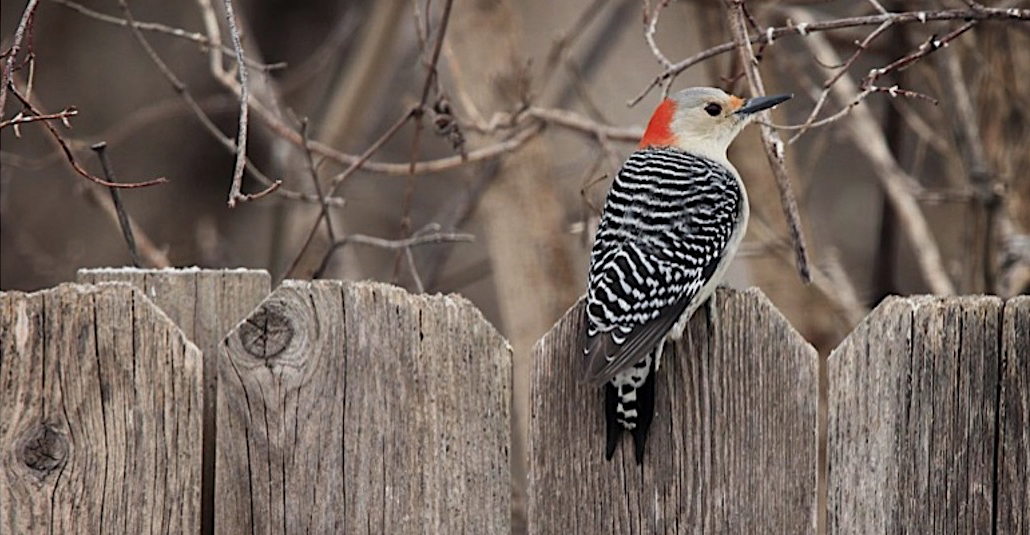BY KIERAN LINDSEY, PhD
Last Sunday morning I unexpectedly found myself sitting ringside for a brief but furious brawl. Two male red-bellied woodpeckers (Melanerpes carolinus) were having a boundary dispute that started with an argument over some shrubbery, then escalated into a full-on aerial assault. Colliding mid-air, they grasped one another by the feet and were so intent on punching, pecking, and plucking that the adversaries flew thoughtlessly over the nearby road directly in front of my car. Luckily, I was making my way slowly along the otherwise quiet suburban street, so I was able to stop and watch.
With my windshield serving as an impromptu HDTV, the smackdown aired for all of 45 thrilling seconds and then, as if in response to a referee’s break command… it was all over. Each fighter retreated, shouting insults over his shoulder as he returned to his corner.

Red-bellied woodpeckers (let’s just shorten that to RBWs, shall we?) are a medium-sized bird—just over 9” (24 cm) from chisel beak to stiff tail tips, with a 13-16” (33-42 cm) wingspan. Like many North American woodpeckers, they wear a black-and-white hounds-tooth jacket, but their bright red Mohawk sets them apart (males sport a full forehead-to-neck cap while females wear an abbreviated version). It’s also the reason these birds are so often misidentified as the similar-sized red-headed woodpecker (Melanerpes erythrocephalus), although once the difference is pointed out the mistake is rarely repeated. RBWs take their name from a subtle scarlet stain on their buffy belly.

Year-round residents in U.S. wetlands, river bottoms, woods, and wooded suburbs from the Midwest east to the Atlantic coast, RBWs are omnivorous, consuming all manner of insects, nuts, seeds, sap, and fruit. They store surplus food in various nooks and crannies and, since they don’t migrate, their larders come in handy during winter. This species employs gender-specific foraging strategies—males search for sustenance primarily along tree boles while females spend the bulk of their time on the boughs.
Biologists don’t often venture out on a limb to officially identify any non-human behavior as play, but I’ve notice the profession has loosened up a bit over the past decade or so, thankfully. One example of this trend was a description of RBW behavior I read recently. This species will periodically engage in swift, nimble, and unpredictable forest flights, complete with many direction changes to dodge trees, and accompanied by constant excited chatter. The author of this resource was quick to explain that the activity probably has a practical application, in that it helps youngsters practice evasive maneuvers that will come in handy should predators be lurking about. However, and surprisingly, the expert also admitted the birds seemed to be having fun.

RBWs are monogamous—for the extent of a breeding season, that is (so perhaps it would be more accurate to say they are serial monogamists)—and both parents are actively involved in raising young. They nest in hardwood and pine trees, along with the occasional fence post and even buildings, by excavating a cavity or stealing one from other birds. What goes around comes around, though—or so says a timeworn adage; RBWs often lose their precious nest holes, in turn, to common starlings (Sturnus vulgaris).
Assuming the pair can hang on to their home, the female lays two to six white eggs on a cushion of wood chip hole construction debris and incubates them for 12 days. The hatchlings are altricial, meaning they begin their lives naked, blind, and helpless. They don’t waste any time growing up, though, and are ready to leave the nest for a first tentative flight when they are 24—27 days old. Depending on the region, the adults may raise from one to three broods in a season.

Defending the homestead is a top priority during the child-rearing seasons, especially if the ‘hood includes a well-tended feeder (a gold mine for species able to digest seeds or suet). Even though most bird nestlings can’t tolerate seeds and need a diet composed largely of insects, when Mom and Dad can grab a quick high-calorie meal on the fly they have extra time to hunt for the more illusive foods their offspring need to develop properly.
Since RBW territories range from 3 to 39 acres, protecting the perimeter is far from a simple task, especially when feeding yourself and your family is a full-time job. So, naturally, breaches occur… but everyone trespasses and is trespassed against. Border skirmishes are common but they rarely result in bloodshed. Research tells us because the intensity of defense behavior decrease as an animal moves away from the center of its territory. Put another way, property rights become less important the farther you are from home. In most cases, both combatants throw in the towel long before there’s a knock-out.
Learn more about the birds who call Lafayette Park home!


